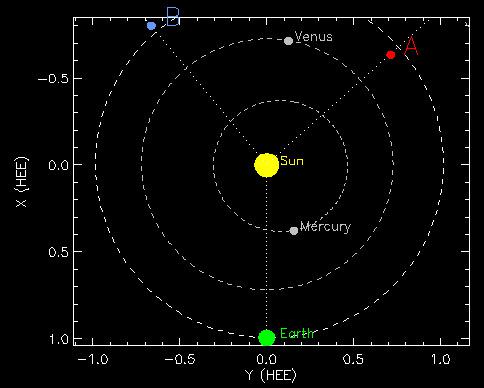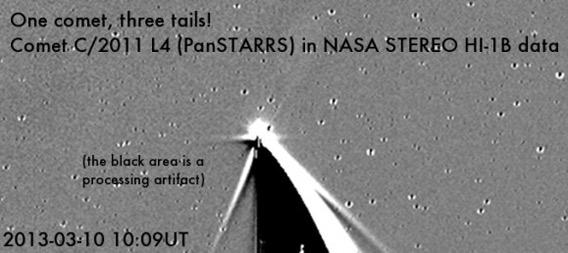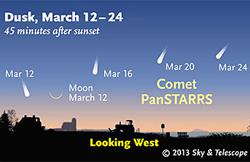For the next week or two, the bright comet called C/2011 L4 (Pan-STARRS) is gracing our skies. For Northern Hemisphere observers, look west shortly after sunset to spot the cosmic visitor; in fact, tonight the thin crescent Moon will be hanging nearby like a landmark (skymark?) to help you spot it.
It’s been cloudy here in Boulder (it snowed all during sunset last night, totally destroying any chance of seeing the comet for me) but some places are better than others for viewing. One of the best is from the STEREO B spacecraft, one of two twin space probes in orbit around the Sun. The STEREO pair were launched in opposite directions to give us a view of the entire Sun, instead of just the part facing us at any given time, and have been returning fantastic data about the Sun since then.
STEREO B has moved far enough around the Sun that it now can see the comet in the same field of view, and the pictures it’s been sending back have been amazing. But this one literally made my jaw drop:

Image credit: NASA/STEREO, via @SungrazerComets
As you can see from the labels, that’s the comet at the bottom. The Sun is just off the left hand edge of the frame, and all the odd fuzzy stuff is material blown off by the Sun in the solar wind (and gusts of wind making up solar storms). You can also see Mercury there, bright enough to overflow the camera’s pixels, causing the light to bloom (creating those long vertical spikes).
But the coolest part of this is the Earth itself, hanging in space off to the right! STEREO B is more than a third of the way around the Sun as seen from Earth, so when it looks at the Sun it’s also looking back on us. From its position, 280 million kilometers away (175 million miles), it can see the Sun, Mercury, the comet, and the Earth all at a glance. Incredible.

Image credit: NASA/STEREO
That STEREO image may look a little funny to you; see how everything has a white side and a black side? No, this isn’t from an old episode of Star Trek. It’s because this is what’s called a “difference image”: It’s literally one image subtracted from another. When you do that, it minimizes things that don’t change, like stars, and accentuates things that do. If something doesn’t change from one image to the next it gets subtracted away, but things that move leave that white/black feature. In this case, the planets and comet moved a tiny bit due to their own motion as well as that of STEREO B. The wind from the Sun did as well, but it’s a big, fuzzy feature, so you get that odd patchiness to it.
That image was taken on Mar. 10, when Pan-STARRS was closest to the Sun. On that same day STEREO B took this image of the comet:

Image credit: NASA/STEREO, via @SungrazerComets
You can clearly see the different tails of the comet. Multiple tails are common; one is made of dust, ground-up rock freed as the frozen ice on and in the comet warms up and sublimates, turning into a gas. The gas itself gets whacked by the solar wind, gets stripped of electrons, and glows like a neon sign, creating the ion tail. The dust tail tends to curve away from the comet, falling behind in the comet’s orbit, while the ion tail gets blown straight back by the particles in the solar wind which are moving far faster than the comet itself. Different ions (like nitrogen, sodium, and so on) behave differently, so you can have several ion tails as seen here.
STEREO B’s view is amazing, but still, there’s nothing like seeing it for yourself. Check Sky and Telescope’s site for viewing info, or the one for Astronomy magazine. I hope you get a chance to see it!
Come to think of it, I hope I do too. And I’ll be posting more amazing pictures of this comet soon, so Stay Tuned.
